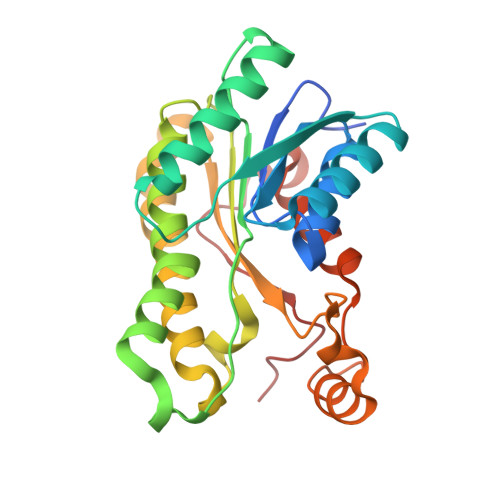Structural and functional analysis of angucycline C-6 ketoreductase LanV involved in landomycin biosynthesis.
Paananen, P., Patrikainen, P., Kallio, P., Mantsala, P., Niemi, J., Niiranen, L., Metsa-Ketela, M.(2013) Biochemistry 52: 5304-5314
- PubMed: 23848284
- DOI: https://doi.org/10.1021/bi400712q
- Primary Citation of Related Structures:
4KWH, 4KWI - PubMed Abstract:
Angucyclines are biologically active natural products constructed around a common benz[a]anthraquinone carbon frame. One key branching point in the biosynthesis of angucyclines is the ketoreduction at C-6, which results in the opposite stereochemistry of landomycins and urdamycins/gaudimycins. Here we present the 1.65 Å resolution crystal structure of LanV from Streptomyces cyanogenus S136 that is responsible for the 6R stereochemistry of landomycins. The enzyme displays the common architectural fold of short-chain alcohol dehydrogenases/reductases and contains bound nicotinamide adenine dinucleotide phosphate. Determination of the structure of LanV in complex with 11-deoxylandomycinone at 2.0 Å resolution indicated that substrate binding does not induce large conformational changes and that substrate recognition occurs mainly through hydrophobic interactions. Analysis of the electron density map of the ternary complex revealed that the catalytic reaction had most likely proceeded backward in the crystal, because the data could be best fit with a compound harboring a carbonyl group at C-6. A coordinated water molecule was atypically identified between the ligand and the conserved Tyr160 residue, which was confirmed to be critical for the catalytic activity by site-directed mutagenesis. A catalytic triad of Ser147, Tyr160, and Lys164 could be recognized on the basis of the crystal structure, and stereoselective labeling studies demonstrated that the transfer of hydride from reduced nicotinamide adenine dinucleotide phosphate to the substrate occurs from the 4-pro-S side of the cosubstrate. Importantly, Ser192 was identified as being involved in controlling the stereochemistry of the reaction, as assays with single mutant Ser192Ile led to accumulation of gaudimycin C with 6S stereochemistry as a minor product.
Organizational Affiliation:
Department of Biochemistry and Food Chemistry, University of Turku , FIN-20014 Turku, Finland.

















